#pathfinder 2e level 0
Explore tagged Tumblr posts
Text



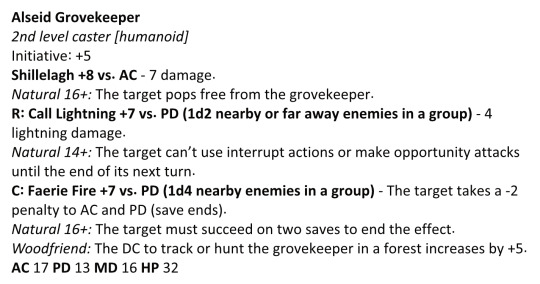
Alseids are graceful, smaller cousins to the more common centaur. Their lower body is that of a woodland deer and their upper bodies have smaller and far more slender proportions than a centaur's. Male alseids also grow antlers, with the horns branching approximately every 10 years until they've lived for a century. Further branches are possible, but are a deeply spiritual event, one which only occurs rarely and is highly celebrated when it does. Alseids believe it is a blessing from the forest, and thus far no one has a more proven explanation. These horns are never used for combat, and any damage to one is a humiliating error or grave insult.
Currently only a few alseid populations are known, and all exist within deep forests. These populations all have a deeply spiritual connection to their forest, knowing it better than any and able to maneuver it without leaving a single track behind. Most act as defenders of their home, whether guiding lost travellers back out or slaughtering trespassers who cut down a single tree. Each herd shares a similar basis for their rules and traditions with personal variations and exceptions. Meeting one group may give an intruder some understanding of how another will act, but differing rules may result in deadly misunderstandings.
Most alseid communities respect druids and rangers deeply, and their leaders favor such traditions. Often the leader of a larger alseid community will be a prince with 11 or more points to their antlers, representing blessings from the forest to lead. At this point, no alseid with 14 or more points to their horns are known of.
Originally from the Tome of Beasts 1. This post came out a week ago on my Patreon. If you want to get access to all my monster conversions early, as well as access to my premade adventures and other material I’m working on, consider backing me there!
Pathfinder 2e
Alseid Warrior Creature 0 CN Medium Beast Perception +7; low-light vision Languages Common, Elven, Sylvan Skills Nature +7, Stealth +5, Survival +7 Str +1, Dex +3, Con +1, Int -1, Wis +3, Cha -1 Woodfriend The alseid always gains the benefits of Cover Tracks in forest surroundings, even while moving at full speed. It also always knows true north. Items leather armor, shortbow (20 arrows) spear AC 14; Fort +5, Ref +7, Will +5 HP 14 Speed 35 feet Melee spear +5, Damage 1d6+1 piercing Ranged shortbow +7 (deadly d10, range increment 60 feet, reload 0), Damage 1d6 Ranged spear +7 (thrown 20 feet), Damage 1d6+1 piercing
Alseid Grovekeeper Creature 5 CN Medium Beast Perception +15; low-light vision Languages Common, Druidic, Elven, Sylvan Skills Diplomacy +11, Nature +15, Stealth +13, Survival +15 Str +3, Dex +4, Con +3, Int +2, Wis +6, Cha +4 Woodfriend The alseid always gains the benefits of Cover Tracks in forest surroundings, even while moving at full speed. It also always knows true north. Items leather armor, staff AC 22; Fort +12, Ref +11, Will +15 HP 70 Speed 35 feet Melee staff +12 (two-handed d8), Damage 1d4+3 bludgeoning Melee shillelagh +13 (two-handed d8), Damage 2d4+3, or 3d4+3 against aberrations, extraplanar creatures, or undead Primal Prepared Spells DC 23, attack +15 ; 3rd dispel magic, lightning bolt; 2nd animal messenger, heat metal, restoration; 1st create water, pass without trace, shillelagh; cantrips (3rd) guidance, light, produce flame, tanglefoot Druid Order Spells 1 Focus Point, DC 23 , 3rd goodberry
13th Age
Alseid Warrior 1st level troop [humanoid] Initiative: +4 Spear +6 vs. AC - 5 damage. Natural Even Hit: The alseid can pop free from the target. R: Shortbow +5 vs. AC (one nearby enemy, or one far away enemy at -2 atk) - 4 damage. Woodfriend: The DC to track or hunt the alseid in a forest increases by +5. AC 17 PD 14 MD 11 HP 28
Alseid Grovekeeper 2nd level caster [humanoid] Initiative: +5 Shillelagh +8 vs. AC - 7 damage. Natural 16+: The target pops free from the grovekeeper. R: Call Lightning +7 vs. PD (1d2 nearby or far away enemies in a group) - 4 lightning damage. Natural 14+: The target can’t use interrupt actions or make opportunity attacks until the end of its next turn. C: Faerie Fire +7 vs. PD (1d4 nearby enemies in a group) - The target takes a -2 penalty to AC and PD (save ends). Natural 16+: The target must succeed on two saves to end the effect. Woodfriend: The DC to track or hunt the grovekeeper in a forest increases by +5. AC 17 PD 13 MD 16 HP 32
#pathfinder 2e#13th age#homebrew#my homebrew#monster#npc#humanoid#beast#pathfinder 2e level 0#pathfinder 2e level 5#13th age level 1#13th age level 2#long post
9 notes
·
View notes
Text


The collaborative map my new Pathfinder group made using The Quiet Year, vs. the redone version I made in Inkarnate!
I'm going to keep adjusting it and adding to it as we get into the game, but this was a lot of fun to do and create with my players!
#The quiet year#pathfinder#map#ttrpg#world maps#island#fantasy world#pathfinder 2e#inkarnate#cartography#desert#level 0#session 0#collaborative#second edition#pf2#collaborative storytelling#maps
14 notes
·
View notes
Text
Camazotz
Pathfinder 2e
Camazotz (Lord of Bats and Fire)
Camazotz was once a simple nabasu demon with great ambition and drive. Among the many nabasu born, he fought his way to greater power, fulfilled his hunger, ascended to become a vrolikai, and then grew even more powerful. He became a nascent demon lord focused over bats and vampires, becoming more and more bat-like as he went, but it wasn’t until he managed to steal the fire aspect of another nascent demon lord that he managed to break through the threshold and become a true demon lord. He solidified his place in the Abyss in one fell swoop, claiming a section of it as his lair and quickly began spreading his following deeper into the material plane among primarily derro and goblins.
Once only found in darkness, his newfound connection with fire and light has bolstered his confidence, and he is becoming more confident in daylight; a confidence that is also spreading to his cults as he recruits more beings comfortable in the day.
Areas of Concern bats, blood drinking, fire Edicts feed on blood and aid creatures that do so, spread fire, proclaim your victories Anathema refuse your ambition, Divine Attribute Constitution or Wisdom
Devotee Benefits Cleric Spells 1st: breathe fire, 4th: vapor form, 5th: moon frenzy Divine Font harm Divine Skill Intimidation Domains ambition, darkness, destruction, fire, Favored Weapon dagger
Created even before his rise to true demon lord, skin bats are one of Camazotz's favorite creations. The flayed skin of a victim sacrificed in his name, fed into a vat of flesh, and granted horrible unlife, these creatures fly in great flocks in Camazotz's Abyssal realm, and he teaches their creation to his followers. They feed on the skin of other beings to replace the constantly rotting components of their own body, peeling it off in horrible strips and fusing it to themselves. They typically have an 8 foot wingspan, despite the relatively small size of their body, and over time its coloration shifts based on the color of the skin it feeds on.

Skin Bat Creature 0 Rare, Small, Mindless, Undead Perception +7; darkvision Skills Acrobatics +5, Stealth +5 Str +1, Dex +3, Con +0, Int -4, Wis +1, Cha -2 AC 15; Fort +4, Ref +7, Will +5 HP 15 (negative healing); Immunities death effects, disease, mental, paralyzed, poison, unconscious Speed 10 feet, fly 40 feet Melee fangs +7 (finesse), Damage 1d4+1 plus attach and critical paralysis Attach [1 action] When a skin bat hits a target larger than itself, it attempts to attach it to that creature. It makes an Acrobatics check against the target's Reflex DC. This attempt neither applies nor counts towards the skin bat's multiple attack penalty. This is similar to grabbing the creature, but the skin bat moves with that creature rather than holding it in place. The skin bat is flat-footed while attached. If the skin bat is killed or pushed away while attached to a creature it has peeled skin from, that creature takes 1d4 persistent bleed damage. Escaping the attach or removing the skin bat in other ways doesn’t cause bleed damage. Critical Paralysis (incapacitation) On a critical hit with fangs, the target must attempt a DC 12 Fortitude saving throw. Critical Success The target is temporarily immune to Critical Paralysis for 1 hour. Success The target is unaffected. Failure The target is slowed 1 for 1d4 rounds. Critical Failure The target is paralyzed for 1d4 rounds. Peel Skin [1 action] (healing); Requirements The skin bat is attached to a creature. Effect The skin bat peels the skin from a creature it's attached to and incorporates it into its own body. This deals 1d4 damage and the skin bat regains Hit Points equal to the damage dealt. If it's at full health, it instead gains temporary Hit Points equal to that amount. A creature that has its skin peeled in this way is sickened and drained 1 until it receives healing (of any kind or amount).
13th Age
Camazotz is a newly minted ruler of a Hellhole, having usurped control from his weakening and decrepit predecessor. Formerly a very powerful bat demon, he inherited fire from the balor Hugotha when he devoured the balor's flesh and now wields it with a fascination that borders on reverence. The Hellhole, formerly decaying and falling in on itself now resurges with vitality and power, hordes of bat demons pouring forth in an unending tide to drown out the lax defenders who'd grown used to Hugotha's laziness. Perhaps this was the wish of the Diabolist, to replace a failing minion, or perhaps Camazotz has overturned her carefully laid out plan to limit the impact of any one particular Hellhole to ensure that her power isn't destroyed with all reality, but either way Camazotz prepares for a far greater invasion of the world.
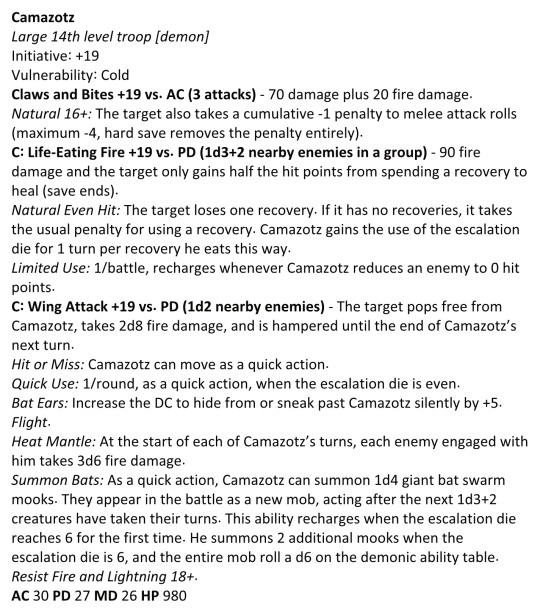
Camazotz Large 14th level troop [demon] Initiative: +19 Vulnerability: Cold Claws and Bites +19 vs. AC (3 attacks) - 70 damage plus 20 fire damage. Natural 16+: The target also takes a cumulative -1 penalty to melee attack rolls (maximum -4, hard save removes the penalty entirely). C: Life-Eating Fire +19 vs. PD (1d3+2 nearby enemies in a group) - 90 fire damage and the target only gains half the hit points from spending a recovery to heal (save ends). Natural Even Hit: The target loses one recovery. If it has no recoveries, it takes the usual penalty for using a recovery. Camazotz gains the use of the escalation die for 1 turn per recovery he eats this way. Limited Use: 1/battle, recharges whenever Camazotz reduces an enemy to 0 hit points. C: Wing Attack +19 vs. PD (1d2 nearby enemies) - The target pops free from Camazotz, takes 2d8 fire damage, and is hampered until the end of Camazotz’s next turn. Hit or Miss: Camazotz can move as a quick action. Quick Use: 1/round, as a quick action, when the escalation die is even. Bat Ears: Increase the DC to hide from or sneak past Camazotz silently by +5. Flight. Heat Mantle: At the start of each of Camazotz’s turns, each enemy engaged with him takes 3d6 fire damage. Summon Bats: As a quick action, Camazotz can summon 1d4 giant bat swarm mooks. They appear in the battle as a new mob, acting after the next 1d3+2 creatures have taken their turns. This ability recharges when the escalation die reaches 6 for the first time. He summons 2 additional mooks when the escalation die is 6, and the entire mob roll a d6 on the demonic ability table. Resist Fire and Lightning 18+. AC 30 PD 27 MD 26 HP 980
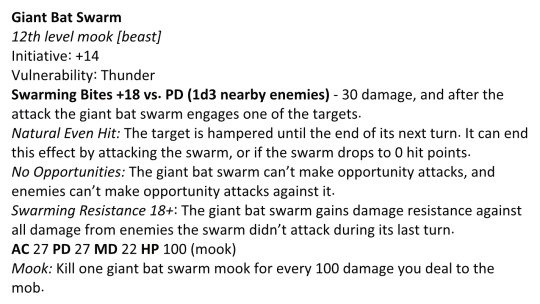
Giant Bat Swarm 12th level mook [beast] Initiative: +14 Vulnerability: Thunder Swarming Bites +18 vs. PD (1d3 nearby enemies) - 30 damage, and after the attack the giant bat swarm engages one of the targets. Natural Even Hit: The target is hampered until the end of its next turn. It can end this effect by attacking the swarm, or if the swarm drops to 0 hit points. No Opportunities: The giant bat swarm can’t make opportunity attacks, and enemies can’t make opportunity attacks against it. Swarming Resistance 18+: The giant bat swarm gains damage resistance against all damage from enemies the swarm didn’t attack during its last turn. AC 27 PD 27 MD 22 HP 100 (mook) Mook: Kill one giant bat swarm mook for every 100 damage you deal to the mob.
#pathfinder 2e#13th age#homebrew#my homebrew#monster#demon#undead#beast#pathfinder level 0#13th age level 14#13th age level 12#long post#tome of beasts
5 notes
·
View notes
Text
Objective Ranking of types of XP systems in ttrpgs
XP is a discreet resource spent on character improvements of the player's choice. Examples: Numenera/Cypher System, Warhammer RPGs, World of Darkness, Shadowrun (even though it's called karma in that one)
XP is primarily used to measure progress to next level, the threshold for next level can be different depending on the character, and can be reduced by the player spending it or by certain events taking it from the player character. XP value is not decreased by gaining a level. Examples: AD&D, Pathfinder 1e
XP is used exclusively to measure progress to next level, is assigned based on relative challenge, and has consistent thresholds to next level between characters. XP value is reset to 0 after gaining a level. Examples: Pathfinder 2e, Dungeon Crawl Classics (and some other OSRs)
XP is used exclusively to measure progress to next level, is based on an arbitrary measurement of the challenges (monsters) that award it, and XP thresholds are consistent between characters. XP values do not decrease after gaining a level. All of the flaws of method #2 (huge numbers, easily confused math) in service of nothing, using method #3 would make more sense in every conceivable way, but you, the designer, are convinced that the trappings of older games will satisfy grognards and the big numbers won't scare new players (wrong on both counts), because your game has to appeal to everyone simultaneously. Also you offer a hand-wavy alternative that puts all the work on the GM so if people don't want to use your shitty XP system the group can just offload the work on the GM like everything else in your game. Examples: d&d 5e pretty much exclusively
61 notes
·
View notes
Text
Open Pathfinder Campaign
HEY YOU YEAH YOU You ever wanted to play Pf2e but never were able to because your GM was too into DND or just because you didn't find anyone to GM it?
WELL! i have the fix to your issues

I'm opening up Six (0/6) Seats on the Pathfinder 2e adventure path of Kingmaker, an adventure path focused on exploration and roleplay potential which has the players go from level 1 to 20. Exploring lands never before charted and raising a kingdom from nothing.
If that sounds up your alley, consider signing up!
This IS A paid campaign. I have been a GM for 7+ years and I can guarantee a professional-grade experience.
The campaign cost is 5 USD per player per session! And to alleviate any concerns, no player can buy items, etc. The cost is just so I can spend more time working on the campaign, weaving your characters into the narrative, and giving it a lot more time and care.
As for scheduling, once at least 4 seats are filled, we can start selecting a date that works for all players interested.
This campaign is extremely open and welcoming to anyone who hasn't tried PF2e before or is wanting to switch from 5e! Or anyone who wants a cool adventure to rock on. Both beginners AND veterans will have plenty of chance to play and enjoy it, so don't be afraid!
If you have interest in joining you can contact me via Tumblr or Via discord!
Discord: brightbluemoona
Payments can be done through Ko-fi or paypal.
If you can't join please Reblog that'd help a lot <3
#pf2e#dnd#ttrpg#5e#Campaign#Pf2e Campaign#pathfinder kingmaker#pf2e Kingmaker#Kingmaker Campaign#Dnd Campaign#Gm for hire#DM for Hire#Dungeon Master For Hire#LFG#Looking for Game#pf2e lfg#dnd lfg#5e lfg#please boost
51 notes
·
View notes
Text
How to Play as Gardevoir in Pathfinder 2e
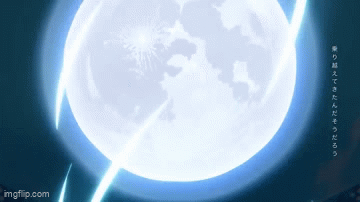
Gardevoir is my favorite Pokemon, and has been since I saw Wally's on Victory Road, got jealous, and completely restarted the game to get a Ralts. I've found that Pathfinder is a lot more flexible than DnD, so I thought it'd be interesting to try building a Pokemon.
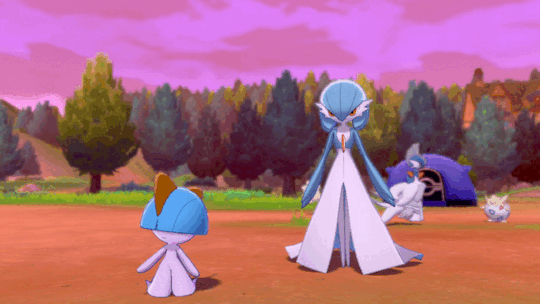
ANCESTRY SEER ELF
I was tempted to make Gardevoir a Poppet or a Sprite. Poppets are tiny constructs in the form of dolls and toys, and the Gardevoir line is inspired by Anesama Ningyo paper dolls. However, Poppets are Small creatures, with Toy Poppets having the option to be Tiny. Sprites are the only playable Fey race in Pathfinder 2e, and the Ralts line are all Fairy-type Pokemon. However, all Sprites are Tiny, except the Pixie Sprite, which can be Small. The Ralts line is also inconsistent in size. Ralts is a Tiny creature being 1'04'', Kirlia is a Small creature being 2'07", and Gardevoir is a Medium sized creature being 5'03". There is no means in Pathfinder for a creature to grow in size permanently. So, why an Elf? Truthfully, it's because while Pathfinder has a lot of Ancestry options, at the same time, the actual number of options is limited. However, Elf does work for Gardevoir. They're tall, thin, and graceful like her. Seer Elves can detect magic around them. If you can talk your DM into ignoring the sizes allowed for Poppets and Sprites, then I would choose the Wishborn Poppets who can succeed against Emotion effects easier, or Draxie Sprites, who can telepathically communicate with anyone they touch.
VARIANT ANCESTRY FEY INFLUENCE
At level 5, any character of any race can choose Fey Influence for their racial feat, unlocking other fey racial feats as they level up. Fey Influence lets you take on features of an Anteater, Cat Sith, Cursed Bluebird, Dryad, Faun, Gremlin, Monarch, or Unicorn. While none of these really stand out as mapping well onto Gardevoir, she does have the horn on her chest, so you could go with the Unicorn. With Fey Influence, the Unicorn gains the ability to cast Heal, and at level 9 with Fey Ascension, the Unicorn makes Gardevoir Trained or Expert in Medicine, and grants her +2 to saves against Poison and Charms. If nothing else, this is another way to add Fey vibes to Gardevoir to fit her Fairy Type.
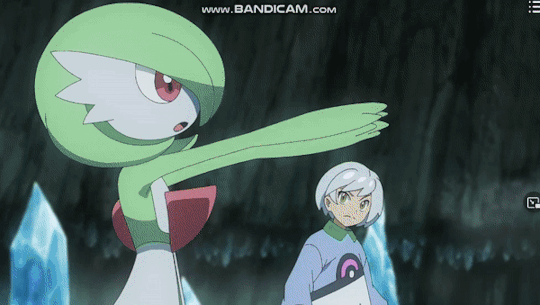
STATS
STR +0 DEX +5 CON -1 INT +6 WIS +5 CHA +5
SKILLS
Trained: Acrobatics, Crafting, Deception, Intimidation, Shelyn Lore, Medicine, Nature, Occultism, Performance, Society, Stealth Expert: Medicine (Fey Influence) Master: Legendary: Arcana, Diplomacy, Religion

PSYCHIC THE DISTANT GRASP EMOTIONAL ACCEPTANCE
There was no doubt which class Gardevoir had to be, she was a Psychic type first before she ever became a Fairy. Psychics also get access to the Occult Spell List, which is loaded with spells that deal with psionics, mental magic, emotion magic, shadow magic, and illusions, making it a very good fit for Gardevoir. The Emotional Acceptance Subconscious Mind means that Gardevoir's psionics manifest through control and expression of her emotional state, which felt fitting for her. Her horn senses the emotions of others, and her earlier stages are each known as The Feeling Pokemon and The Emotion Pokemon.
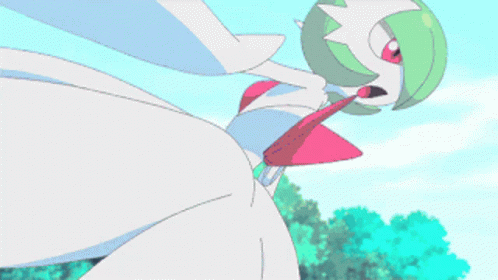
CLOISTERED CLERIC Of SHELYN (Archetype) REPOSE, PROTECTION, or FAMILY DOMAIN
Shelyn is the Golarian goddess of love, a fitting choice for the Embrace Pokemon. Shelyn's Domains also fit Gardevoir well. Protection lets Gardevoir take damage for an ally and create a protective area. Repose lets Gardevoir steel her allies against Emotion spells, and later can create a soothing beacon where allies can cleanse themselves of negative emotion conditions. The Family Domain bolsters ally Wisdom Saving Throws, and moreso against Emotion spells. In addition, it can also attempt to remove a negative emotion condition. Later, the Family Domain can share their spell saving throw modifier with their allies to protect them against spells. All three domain options make Gardevoir an excellent guardian protecting her friends and allies. Unlike DnD where a Cleric can only embody one Domain, Clerics have class feats that let them invest in as many domains as they want to, provided their Deity grants access to those Domains. Each deity also adds 3 spells to the Divine Spell List that their Clerics can choose to prepare. Clerics of Shelyn get to add Dizzying Colors, Enthrall, and Creation to the Divine Spell List. Gardevoir must be Legendary in Religion to gain access to high level Divine spells through this archetype.
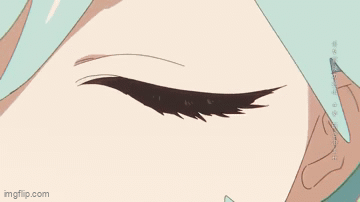
FEY BLOODLINE SORCERER (Archetype)
Gardevoir is also a Fairy-type, and the Divine Spell List doesn't really add much in the way of Fey magic. Unlike Cleric and Psychic where the class has a set Spell List, the Sorcerer's Spell List changes depending on your Bloodline. The Fey Bloodline grants the Primal Spell List. Ordinarily, a Sorcerer gets granted spells like the Psychic, but when taken as an Archetype, these spells are not gained automatically. However, a Sorcerer Archetype can still choose spells from their Granted Spell List as though they were on the Primal Spell List. In addition to the Primal Spell List, the Fey Bloodline Sorcerer gets access to: Figment, Charm, Laughing Fit, Enthrall, Suggestion, Cloak of Colors, Mislead, Visions of Danger, Uncontrollable Dance, and Resplendent Mansion. Gardevoir must be Legendary in Nature to gain access to high level Primal spells. While I feel that Cleric better grants Gardevoir the types of spells she would use, Fey Bloodline does well to grant her the elemental coverage moves she can learn through TMs. So, I'll leave my recommended spell list if you choose Fey Bloodline instead of Cloistered Cleric.
C Frostbite, Vitality Lash 1 Heal, Chilling Spray 2 Entangling Flora, Mist 3 Moonlight Ray, Fireball 4 Radiant Beam, Petal Storm 5 Elemental Breath, Lightning Storm 6 Field of Life, Moonlight Ray(+3) 7 Eclipse Burst 8 Moonburst(+1)

Psychic Spells Cleric Archetype Spells
C Phase Bolt, Telekinetic Projectile, Warp Step, Guidance, Shield 1 Kinetic Ram; Force Barrage, Soothe, Heal, Sanctuary 2 Telekinetic Maneuver; Empathic Link, Noise Blast, Clear Mind, Restoration 3 Levitate; Martyr's Intervention, Percussive Impact, Moonlight Ray, Protection(+2) 4 Fly; Chromatic Ray, Mirror's Misfortune, Cloak of Light, Radiant Beam 5 Telekinetic Haul; Repelling Pulse, Synaptic Pulse, Moonlight Ray(+2), Spiritual Torrent 6 Poltergeist's Fury; Scintillating Safeguard, Collective Transposition, Field of Life, Spirit Blast 7 Telekinetic Bombardment; Prismatic Spray, Shadow Raid, Eclipse Burst 8 Falling Sky; Scintillating Pattern, Spirit Song, Moonburst(+1) 9 Foresight; Phantasmagoria, Prismatic Sphere 10 Freeze Time, Gate
SIGNATURE SPELLS 1 Force Barrage 2 Noise Blast 3 Percussive Impact 4 Chromatic Ray 5 Repelling Pulse 6 Poltergeist's Fury 7 Telekinetic Bombardment 8 Spirit Song 9 Phantasmagoria

FOCUS SPELLS
C Telekinetic Hand (Amped) C Telekinetic Projectile (Amped) C Telekinetic Rend C Vector Screen C Dancing Blade
10 Soothing Words (Family Domain) 10 Unity (Family Domain)

INNATE SPELLS
Detect Magic Mindlink (Elves only)

Conclusion
Ultimately, I come away satisfied with this build. It may not be able to do every single thing Gardevoir can do, but it feels appropriate to what Gardevoir is and the core of its design. It has a plethora of telekinetic abilities, it has options to include its Fairy typing, and it even works her protective nature into her abilities. This will be far from the last character I build in Pathfinder. So, who do you want to see next?
#pathfinder#pathfinder 2e#pf2e#pf2#gardevoir#ralts#kirlia#pokemon#pokémon#hoenn#hoenn region#pokemon ruby and sapphire#pokemon emerald#mega gardevoir
40 notes
·
View notes
Text
Just had the Session 0 for my new Pathfinder 2e campaign. I'm running the Extinction Curse adventure path, aka the one where we are all circus folk. Currently our lineup consists of:
The Ringmaster, a Catfolk Thaumaturge (who will be picking up the Sorceror free archetype) and is intended to be sort of a battle commander type on the field. Uses a ringmaster's baton as a wand.
The Strongman, a Kashishi Giant-instinct Barbarian whose primary weapon is a large Poi/Fire Spinner as a Meteor Hammer. So this weirdly buff little psychic rhino man with the personality of an erudite gentleman who sometimes takes off his monocle and gets very, very big.
The Trick Shooter, a Poppet Pistolero Gunslinger with a Corgi mount. Think Jessie from Toy Story 2 with pink hair and elf ears riding around on a hundred pound corgi doing ridiculous trick shots with a pair of slide pistols.
The Cook, a Bear Wood Kineticist. Just a bear. Perfectly ordinary bear. Ignore the opposable thumbs and human-level intelligence or that she can summon tree trunks to hit you with. Also can summon Healing Yams.
The Newbie, a Half-Elf Sorceror of the Angelic Bloodline. The cute new kid who ran away to join the circus (with permission, apparently?) and I'm still kind of haggling with the player on this one to make it work as they want to play Sailor V. Which I'm fine with, just trying to tweak it to make it work with the team as we're honestly a little heavy on the healers and I feel like half the team is "Okay, I want to be support!" while being kind of light on the skill monkeys. So I'm suggesting maybe consider Elf Nephelim Bard/Sorceror to get the same angelic/celestial theme while bringing some more utility and firepower to the table.
This is going to be fun. :D
8 notes
·
View notes
Text
Grailfinders Viewers' Choice #15: V1

today on Grailfinders it’s our first Viewers’ Choice build in Pathfinder 2e, V1 from Ultrakill! the long and short is: he robot, he go to hell, he shoot everything there. he’s like the Doomguy, if the Doomguy ate hell as he went. or if the Doomguy had an official dakimakura of him in a schoolgirl’s uniform.
yeah, Ultrakill gets weird at times. anyways, V1’s a Pistolero Gunslinger to pull of sick trickshots with his pistol, but he’s also getting the Sterling Dynamo dedication to pick up some extra literal arms from his brother and he’s an Occult Witch to pick up some figurative arms from hell.
check out his build breakdown below the cut, or his character sheet over here!
Ancestry & Background
unlike wotc, Paizo realized that there’s more than one kind of robot in the world, so we actually have some choice this time around. that being said, we’re making V1 an Automaton, both for its combat capabilities and because it too is the last vestiges of a dying civilization. You get a stat boost in Strength and one ability of your choice like Dexterity, and you also gain access to Low-Light Vision. as Something Wicked taught us many painful times, V1 does not have true darkvision. because of your Automaton Core, you’re not really a construct, and can be healed and damaged like a normal humanoid. while that removes some resistances and immunities, it also means you won’t instantly die at 0 HP, so checks and balances.
on the plus side, you still have a Constructed Body, so you don’t need to eat, drink, or sleep. you still need to take a long rest, but you’re not unconscious for the 2 hours it takes. really frees up the ol’ calendar for some speedrun practice.
while your punches are pretty powerful, this is a first-person shooter, so you’re starting off as a Sharpshooter Automaton. this gives you the Automaton Aim action, reducing the accuracy penalty for firing your gun at a longer range. trust me, nobody wants to be up close and personal with a Sisyphean Insurrectionist.
if you do fight in close quarters, you’re going to want something better than a regular old fist to fight with, right? the Automaton Armament you get gives you a Claw attack, dealing slashing damage and using your dexterity to aim.
at level 5, your Arcane Safeguards let you Resist Magic as a reaction, adding +1 to your save against a spell, and also increasing the odds of a critical success against arcane spells. most of your adventure is in hell, so failing against a plane shift would be really awkward.
at level 9 your wings finally do something, thanks to Arcane Propulsion. once a day, you can fly for up to five minutes. I know you technically can’t fly in Ultrakill, but have you seen some of those speedruns? you can fly enough.
at level 13 you get a Rain of Bolts, letting you fire shrapnel in either a cone or in a circle around you once per day. man, that minigun has a worse recharge time than I remembered…
at level 17 your Astral Blink gives you sick gamer reflexes, so you can Dimension Door once an hour at 4th level. grappling hooks- always cool.
oh, and of course you’re a Warrior. not much else for a literal killing machine to be, really. boosts to Constitution and Dexterity, training in Intimidation, and the Intimidating Glare feat. I don’t think V1 even has a mouth, so this’ll help a lot.
Levels
1. okay, first up the proficiencies: trained in Will saves and Class DCs, Unarmed, Simple, and Martial attacks, as well as Unarmored, Light, and Medium defense. you start off trained in Occultism, Acrobatics and Religion to fight demons and know what you’re fighting, and as you level up your intelligence you get training in Athletics, Arcana, Medicine, and Diplomacy. you’re an expert in Perception, Fortitude and Reflex saves, as well as Simple and Martial firearms and crossbows. we’d prefer firearms, but if you gotta fit in, you gotta fit in.
as for your actual level, your Key Ability as a gunslinger is Dexterity. you also get an Ability Boost off the bat for some more Strength, Dexterity, Constitution, and Intelligence. be prepared for 0 boosts to Charisma, V1 just straight-up does not talk.
if you get attacked, you can Hit the Dirt! and leap out of the way, giving you a bonus to your AC and knocking you prone when you land. that’s a combat slide baby!
you’re also trained in the Way of the Pistolero, training you in Deception (though I still want to use Intimidation as the way skill), and giving you a Raconteur’s Reload. that means you can demoralize or create a diversion and reload in the same action!
you can also move Ten Paces as a free action when combat starts. you get a plus 2 to the initiative roll, and you can draw your pistol at the same time. you can also step up to 10’ away as a free action at the start of your first turn.
your Singular Expertise gives you a +1 bonus to all damage from firearms and crossbows, at the cost of reducing your proficiency with other weapons. they’re all trained, and they can’t be improved until your gun skills do. it’s not a huge deal since you don’t use that many regular weapons anyway, but it’s something to keep in mind if you intend to modify this build at home.
2. a level 2 you can make a timely Pistol Twirl as an action to feint an opponent nearby. if you succeed they’re flat-footed against your ranged and melee attacks, if you critically fail, you’re flat-footed against all their attacks. it’s not quite a charged shot, but you’re more likely to get a critical hit, so I’ll count it.
you can also Cat Fall, reducing all your falling damage. I don’t think Ultrakill even has fall damage, right? Either you live or you don’t.
I guess we’re facing off against V2 now, since you’re already getting your Sterling Dynamo dedication. with this, you can replace a limb or add a new one, though you can’t get an extra hand this way. yes, sadly we won’t be quadruple-wielding this build. I know, now it’s unplayable.
the good news is that it’s silver, so it deals extra damage against devils, and the Power Driver Dynamo you get deals more damage (a d8) than your stock hand while also shoving creatures around. You have to keep a hand free to use this, but you’re not really getting any two-handed weapons anyway. The one other downside is you need to keep the whole thing wound up, spending a minute to wind it for the next 24 hours. this doesn’t sound bad, but enemies can disable the thing to cut down the timer, and later you’ll get abilities that spend windup time. there’s a reason most of your fights only last a few minutes.
3. at third level you become Fleet, giving you an extra 5’ of movement speed. it’s no monk movement, but that does speed you up enough to change your leap to a max of 15’ in a go. you’re also better at Occultism now. it’s not useful yet, but you need to know a lot about hell in order to get down there. without dying, I mean. getting to hell is real easy if you don’t mind being stuck down there.
you’re also Stubborn, improving your Will Saves and you can save more often against being controlled. I doubt there’s that many people in hell with 1337 hacker skillz, but it’s better safe than sorry, y’know?
4. at level four you kind of get your shotgun, allowing you to perform a Black Powder Boost. Whenever you leap, you can spend some ammo to go an extra 10’. so yes, now you can move as much as most player characters can in an action as a reaction. you’re not super-fast, but god are you hard to pin down.
when you land without taking damage, you can make a Rolling Landing as a reaction to step away from your landing point. this will also improve as your acrobatics does- as an expert you can stride up to half your speed, as a master you can move at full speed, and as a legend you don’t trigger reactions.
finally, you tinker around with v2’s arm a bit to make it a Modular Dynamo. I’m sure he won’t mind. now you can swap your power driver for Entangling Barbs or vice-versa as an action, giving you a short-range grappling hook for enemies. we’ll get the real one later, don’t worry.
5. at level five you get another Ability Boost in Strength, Dexterity, Constitution, and Intelligence. your Gunslinger Weapon Mastery bumps up your proficiency with all your weapons, and you’re an expert in Acrobatics for better movement tech.
6. at level six we finally get a shotgun proper thanks to Scatter Blast. I mean you can always just buy a shotgun (and you need to for this action to work) but now it’s Ultrakill-tier, with a longer range and a wider scatter shot. it even explodes now! directly on you, with a critical failure! this is why most people don’t punch their own guns.
you become an Underwater Marauder, preventing you from being flat-footed while swimming, and you can use your fists without penalty. hey, the water level’s going to happen eventually, might as well prepare for it.
you can also Piston Punch with v2’s arm, attacking two creatures at the same time at the cost of two actions and an hour of winding.
7. at level seven you can Skitter while prone, crawling up to half your speed when you move. it’s hard to match Ultrakill’s movement in a turn-based game, but at least you can slide around wherever you want now.
you’re also a master in Acrobatics now, giving you even more space to move around with, and your Vigilant Senses make you a master in Perception. finally, your Weapon Specialization adds extra damage to all the weapons you specialize in. currently, that’s a +3 to most firearms, and a +2 to your unarmed attacks.
8. at level eight you can Leap and Fire when you hit the dirt, letting you take a shot at whoever triggered the reaction mid-leap. this is about as close as we’re getting to a true parry system, but you deal more damage with your guns anyway, so… close enough.
we’re not done upgrading your reactionary dodges though, since with Kip Up you can stand from prone as a free action without triggering attacks. now you can finally boost dodge, something you could do since… the first level in-game. this is going a bit out of order, sorry about that.
we also finally get your Witch Dedication, which will let us start filling out the rest of your arsenal. we’re picking an Occult patron, since that’s probably what devils count as, right? At least I assume it’s some kind of devil leaving guns all over the place in hell…
you get trained in occult spellcasting, and you also get trained in Survival. to be honest, most of these skills aren’t really something we need for the build- turns out a silent murder machine isn’t that complicated. still, we had to pick something.
as a witch, you get a familiar, which is basically a living spellbook. they come packed with a couple cantrips, but you can only pick one per day, so we’re only going over one or two spells per level. Warp Step will greatly increase your speed, giving you an extra five feet of movement for a turn and letting you stride or fly twice as part of the two-action spell. if you’d rather focus on looking cool, Musical Accompaniment will give you that sweet sweet Ultrakill soundtrack in the background, giving you a +1 bonus to performance checks for a minute, and possibly some other checks as well, as deemed appropriate by your DM. all this comes at a cost to your stealth checks, which- yeah, duh. it’s hard to sneak with a boombox on your back
9. at ninth level your advanced deed, Pistolero’s Retort unlocks. with this, you can react to someone nearby critically failing an attack on you to take a shot on them. again, not quite a parry, but the spirit is there.
you also have Gunslinger Expertise, which does what you’d think, and you’re now a master in Occultism. we’re still not at the point where we can invade hell yet, but we’ll get something nice next level for your trouble.
10. finally, tenth level is here! bump up your Strength Dexterity Constitution and Intelligence again, then grab Deflecting Shot to parry a wider range of attacks- if a nearby ally would get hit, you can fire a shot to add 2 to their AC. and don’t worry, you’ll know if the +2 will make a difference, since you can use this after the attack is declared.
your sliding also gets boosted thanks to Nimble Crawl. Currently, it’s the same as skittering, but as you improve in acrobatics, you can crawl at full speed, and as a legend you won’t even be flat-footed, allowing you to finally have a proper shootout sliding around like a greased pig, just the way god intended.
you also get access to Basic Witch Casting, giving you one spell slot per day for 1st, 2nd, and 3rd level spells. Gravitational Pull is a first level spell that pulls a creature up to 20 feet closer to you if they fail a fortitude save, knocking them prone on a critical failure. sadly, this doesn’t pull you towards them on a success, but that would be cool, huh? you could also grab a Kinetic Ram to push creatures away from you like v2’s arm should.
for your second level spell, Inner Radiance Torrent is a must have for your railgun. you can spend two actions to two rounds on this spell, making it either a 60’ or 120’ line. if you spend two whole turns charging it up, you deal extra damage and irradiate yourself for a minute. you can also Shatter for your shotgun’s alt fire.
finally, your third level spells! Vampiric Touch is a must-have, finally letting you drink the blood of your enemies for healing! you deal negative damage to an enemy in melee range, gaining temporary HP out of the deal for 1 minute. you can also grab Ghostly Weapon to fight Mindflayers. I think they’re ghosts? I don’t know.
11. eleventh level gunslingers get Evasion, mastering your reflex saves and improving your successes with them. you can also Siphon Life by spending two actions now! I know you have to get dropped to 0 HP by a negative enemy first, but I mean. it’s hell. there’s going to be negative enemies there. and if you’ve managed to do a deathless run of Ultrakill so far, that’s as impressive as it is unlikely.
still, this means you can deal extra negative damage when you punch a living creature, forcing a fortitude save against them and healing you based on how much damage takes.
you’re also more Athletic now, congrats.
12. at level twelve, your Ricochet Shot finally lets you bounce a bullet off a coin to ignore cover. I know this is the second gun you get in the game, but to be fair you don’t have to buy it right away.
you can also Quick Jump, so now your black powder boosts can be added to your High and Long jumps as well, while also packaging everything into one action.
finally, you take a Basic Lesson in Witchcraft, learning the Lesson of Calamity. you learn the Stumbling Curse hex to mess around with your enemy’s movement via creative usage of grappling hooks, while your familiar learns Ill Omen. if their target fails a will save, they get disadvantage on at least one attack roll or skill check next turn. this way you can still mess around with the grappling hook, even if your enemy is too heavy to move that often.
13. at lucky level 13 you become a Gunslinging Legend, improving your training with all weapons once more. you also gain Medium Armor Expertise, improving your armor training. you’re also an expert in Intimidation now. I mean you can basically intimidate for free every time you reload, you might as well be good at it, right?
14. as a 14th level gunslinger you can perform a Dance of Thunder, spending all three of your actions to just viciously abuse the action economy. You can now step, strike a nearby enemy, and reload, repeating the three actions each time you successfully hit your target up to two more times. all this comes at the cost of making your fatigued for a minute afterwards, reducing your AC and saves, but it won’t matter much if your enemies are all dead, right?
you know what we need? better boosts. with Powerful Leap, your leaps can move five feet vertically, or an extra five feet horizontally. that means you can now move further than most people can move in an action as a reaction, shoot the guy who tried to attack you, and finish it all off standing. now I’m pretty confident we’re matching ultrakill in terms of movement. maybe not the weird momentum stuff, but we’ve still got six levels to go.
you also learn some Expert Witch Spellcasting, improving your occult spell training and giving you a fourth and fifth level spell now, with a sixth level spell to come. with your fourth level slot, we can finally use everyone’s favorite weapon, the drill! Dimension Anchor can keep an enemy from teleporting for up to an hour, but if you’d rather have a bunch of blood and damage the Vampiric Maiden can help out. it deals damage, gives you temporary HP, and can immobilize an enemy for a round.
for your fifth level spell, grab Repelling Pulse to really knock a creature around and deal damage at the same time.
15. another Ability Boost, this time into Strength, Dexterity, Intelligence, and Wisdom to shake things up. you also become a Titan Wrestler, allowing you to shove and grapple creatures up to two sizes larger. I’m pretty sure this means King Minos is still out of your weight class, but I’m sure we’ll figure out some way to parry him later.
you now have a Grim Swagger while wielding your gun, making an intimidation check against the will dcs of all creatures in 30’, frightening them or making them flee on a success. I know it’s tempting to use an Ultrakill meme for this, but fight the urge! you can do it, I believe in you.
you also have a Greater Weapon Specialization, and the greatest skill in Acrobatics. you now take no falling damage from any height, can move up to 30’ when you hit the ground without causing an attack, and you can slide around at full speed with no downside.
16. at level 16 you can parry ranged attacks with an Instant Return, catching a bullet out of the air and firing it back at the poor son of a bitch who tried to shoot you.
you’re also better with speed tech now thanks to Aerobatics Mastery helping you maneuver in flight.
you can also use Murksight to see through fog, mist, rain, and snow. you’re just as accurate in Wrath as you are anywhere else, and given how much blood you get on you on a daily basis, that probably counts as rain too.
you also get that sixth level spell slot I was talking about. Suspended Retribution lets you get a real counterattack off if you read your target right. You pick a specific trigger, and then for the next minute the target will take 70 points of damage whenever they activate the spell, though they can also waste a whole turn to remove it. either you restrict the enemy’s attack pattern, or you get a free turn. either way, a fun spell.
17. you’re now a Juggernaut, making you a master of Fortitude and improving your successful saves. robots! pretty tough. they should make armies out of the things.
your Shootists Edge makes you a master of your Class DC, and your mastered firearms can now completely ignore the range penalty when firing them. that’s the great thing about robot gunslingers- no breathing or heartbeats to affect their aim. you’re also Legendary in Occultism now- it’s a secret tool that’ll help us later.
18. it’s later! you now know Master Witch Spellcrafting, improving your spell power again and giving you a seventh level spell! there’s just one we want this time- the spell Plane Shift. Now you can finally invade hell, just like you always wanted! So I guess we haven’t played any of the game yet? Kind of makes sense, Hell is a tough place to invade. don’t ask where we got the arm though.
you can also use Bizarre Magic to make it harder for people to recognize or identify spells you cast. turns out, it’s hard to translate binary on the fly, who knew?
you can now Reach for the Stars when you use a black powder boost. for each dose of power or piece of ammunition spent, you can add another 10’ to your leap, up to five times in a single jump. that means you can leap up to 80’ as a reaction, changing direction with each piece of black powder used. now we have matched Ultrakill in terms of stupid momentum bullshit.
19. for your 19th level, your True Perception gives you a permanent True Seeing spell. now you see the world for what it truly is, a… visual novel? weird. you can get that thanks to your Incredible Senses making you legendary in perception. you also have Medium Armor Mastery, improving your armor training to master. you’re also a master in Intimidation now. I know this isn’t as ridiculous as last level, but I wanted you to have plenty of time to enjoy blowing yourself up.
20. finally, you hit level 20. you get one last Ability Boost in Strength, Dexterity, Constitution, and Wisdom, and your Slinger’s Reflexes give you an extra reaction each turn for counterattacks.
now that you’ve filled out the in-game encyclopedia, you have Assured Identification, making it easier to identify magic. thank god.
one last thing before you go- you learn the Lesson of Death as your final witchy bonus. sure, the Curse of Death is cool, dealing tons of damage and killing an enemy in 3-4 rounds, but the real reason we’re here is so your familiar can learn Raise Dead, because Gabriel knows you aren’t getting through this game without it.
oh right, one last thing before the pros and cons- your eighth level spell, Devour Life. force a fortitude save on a target, dealing 60 negative damage and healing you for half that in real HP. excess is temporary, and if this takes a target to 0 HP they instantly die. simple, effective, and very, very bloody.
Pros & Cons
Pros:
your positioning on the battlefield is super important in Pathfinder, and V1 is one of the best builds we’ve done to date when it comes to controlling his own position as well as his enemy’s. He’s relatively fast, can slide around and fly, and most importantly he can move reactively, which saves his actions for attacking while also giving him a better idea of where to move, and that’s all before we talk about how he can push and pull enemies like he’s taking their turns for them.
He’s also great at abusing the Action Economy, with Hit the Dirt effectively giving him an extra move and attack action from pretty early on in the build, plus his Dance of Thunder letting him take three turns in one go to cap off a fight.
a lot of times, damage focused characters have issues with longevity, especially when it comes to healing themselves. V1 does not have that problem, with his vampirism allowing him to patch himself up without losing out on damage.
Cons:
unlike Ultrakill, you have limited ammunition in Pathfinder. maybe. obviously it depends on your DM, but when you’re using five bullets per reaction they’re going to cut you off eventually. you also have limited ammo in terms of your spells- only having one slot per level seriously limits how often you can cast stuff.
you’re great in combat, but you’re practically a dead fish when it comes to socialization. you have almost no skills except for threatening people, and even then you have the lowest charisma score possible. there’s a reason you’re a silent protagonist. and alone.
a lot of your abilities don’t become useful right away. we barely use intimidation at all, and your occultism uses up a lot of skill improvements despite the fact that we use it for almost nothing beyond unlocking spells in the second half of the build.
27 notes
·
View notes
Text
Coolest thing I found out about Pathfinder 2e as I've slowly moved in is the adventure paths. The main paths have player handouts for free on the site. Most modern ones tend around 7-10 pages (though the early ones were practically books by themselves.) They give a synopsis of the themes of the campaigns, an explanation of any adventure-specific gimmicks, background info the characters would know, and all the character options like backgrounds and spells and such. If you have a home base or reoccurring starting town, they even give little maps with a few important NPCs, so the players can plan things out easier. Best of all, they let you know "hey, there are moments where diplomacy can shine, but you're spending a lot of time in dungeons so there's not a web of intrigue in this one." or "Hey, it's a magic school, but martial classes will work, ranger especially. We ask the GM to use the free archetype rule so martial classes can grab some magic."
1- That's just useful as hell and I don't know how I hadn't thought of that before. Like, it's a summarized session 0 for reference, along with some basic notes to tide them over for the first few sessions and some places they could poke around. Maybe I'll start making a list for my campaigns too, a little page or two of "here's things the character would know, here's the people in your home base, here's the world map as you know it." 2- I get that it's half preview so DMs know what they're buying, but putting the new spell options and backgrounds in such in a freebie for everyone is bold! You gotta have confidence in your adventure for that. Especially because the wiki, archives of nethys, seems to be officially sanctioned to slap every source book and free thing onto itself. 3- Reading through some of these...yeah they have good reason to be that confident. I figured that they wouldn't get worse since the ones I used to read in 1st edition, or what I read for Starfinder, but still! Granted, this is my type of book. I prefer a book to tell me everything I could want to know, flesh out all the characters, and let me cut out stuff I don't want. I don't like 5e's "here's a vague idea, ~you can make the rest whatever you like!~" It's just refreshing. Many of them go all the way to level 20, NPCs don't just vanish into air when you're done, wide varieties of themes between adventures. And again, consistently giving me rules and options and things to do instead of saying "lol just do what ya want?" Feels good. Though take with a grain of salt as I've yet to really run through these, just some cursory playtests to see how encounters feel. I'll follow up if opinions change, but I've run paizo books before to good success. 4- I'm really digging how the adventures come out in 3 to 6 books, often nearing 100 pages each. Like I know the actual reason, there's at least 1 per month with enough content to last that long or more, keep you on that monthly adventure subscription. However, if your party goes off the rails, you can just decide to not pick up that last book. Party decided they didn't like it? hurts a lot less when it was just the $20 for that opening section. And yeah, it's better to get them all at once so you can set up better foreshadowing...but you can just look at one of the many community guides for your section that will point out what parts will be coming back. Honestly, community support for most of these paths seem pretty good, both in guides and homebrew supplemental material. Glad to see that never changed.
14 notes
·
View notes
Text
Alright, Pathfinder 2e build time again. This time - Gambit.
Gambit as a design is tricky for most systems built for heroic fantasy RPGs, even ones embracing a kitchen sink setting. It's probably easiest to just reskin regular old spellcasting as throwing cards, but this is an attempt at making it work within mechanics.
So we're going to follow Pathfinder ABCs
Ancestry - Human - Versatile Heritage (Human doesn't do much special, but the Versatile Heritage gives us a free Level 1 feat that we'll take for Fleet for an extra 5 ft. of movement per action because moving farther is always good and appropriate for Gambit)
Background - Criminal (Obviously, it's Gambit, but this also gives him proficiency in Stealth, Criminal Underworld Lore, and a feat that makes him a better smuggler)
Class - Magus (Magus is a class that fights with weapons, can cast limited spells, and more importantly can channel spells into their attacks.)
Hybrid Study - Starlit Span (This is our Magus subclass - this one makes our coolest Magus abilities centered around ranged attacks. Early on, these will be Throwing Knives and occasionally channeled into our staff, but later on, we'll switch over to mostly our cards.)
Ancestry Feat - General Training - Pickpocket (This is an ancestry feat that gives us an extra general feat. We'll take Pickpocket to continue leaning into our Thieves' Guild Gambit)
Ancestry Paragon Feat - Natural Ambition - Magus' Analysis (This is an ancestry feat that gives us an extra Level 1 Class feat. This one gives us bonuses to Recall Knowledge (i.e. figure out info) about a target we've already hit and if we succeed, we get another use out of our Spellstrike. Handy.)
With our Attribute Boosts we end up with Str +0, Con +1, Wis +0, Dex +4, Int +1, Cha +3. This isn't an amazing spread, but we throw and attack with Finesse weapons very well, and are quite charming. We'll want to keep raising our Int, to improve spell damage, but we should be attacking or Spellstriking way more often than casting spells.
Take Skill Training in Diplomacy, Thievery, and Acrobatics, because of course, it's Gambit.
Level 2 we take Expansive Spellstrike as our Class Feat. This expands what kind of spells we can use in our Spellstrike to include spells with areas of effect.
Take the Skill Feat Bon Mot so you can fling Marvel one-liners at enemies during combat to mess with their Will Saves and Perception.
Pick Rogue as our Free Archetype. This gives us a new Skill Feat. We take Subtle Theft to keep getting better at Pickpocketing.
For our two Skill Trainings we take Deception and Occultism. Someone that knows about the X-Ternal probably knows Occultism too right?
For Level 3, we can go ahead and boost Thievery to Expert because, why not. It fits.
For our Ancestry Paragon feat, take Courteous Comeback. It lets you reroll failed Diplomacy checks pretty infrequently, but it fits flavor with backhanded Cajun compliments.
Then take Arcane Sense for the general feat because why wouldn't you want an innate Detect Magic?
Finally, at Level 4, being Gambit finishes coming online. We take Force Fang as our Class Feat, which gives us a new focus spell that lets our ranged attack basically be a 1 action magic missile.
Our Free Archetype is the important one. We take Fouberie which lets us two hand a deck of cards and enter a card throwing stance, state whether they are being used as daggers or darts, and now we're wielding 52 throwing weapons. (To note, I see no issue stating these are throwing knives, but that's GM choice)
And for Skill Feat, take Concealing Legerdemain so we're even better as a smuggler, concealing items hidden on our person via sleight of hand.
And that's really the bulk of it. Our card stance keeps us from entering Arcane Cascade, which would let us color our normal strikes with the previous spell's damage, but we're more focused on chucking cards, dancing around, and spell striking with our cards whenever we can.
Later levels let us take other Rogue feats like Strong Arm to increase card throw distance and Quick Draw if we need to break out our cards or melee weapon in a pinch. (I recommend taking a Whipstaff. It's an uncommon Level 0 weapon, so generally viable for starting character with GM permission. Once you show them what you're doing, they really shouldn't raise a fuss unless they're boring.)
Other than that, I mean, the rest is up to you. You've already got a passable heroic fantasy Gambit. Now it's just your choice on how to be even better.

16 notes
·
View notes
Text


Alehouse drakes are small dragons, roughly the size of a large housecat, and are among the more friendly and genial of the drakes. Intelligent and lazy, they much prefer finding a comfortable bar, trading house, or coaching inn, and living in the rafters or cellar, justifying their presence by killing pests and throwing a fit if evicted. While not the most lethal of creatures, their small teeth and claws painful but hard pressed to kill quickly, they have enough magic and abilities that can make dealing with one a huge pain that few proprietors are willing to put up with the effort. Letting the drake have access to some of the ale and pull occasional pranks on customers is preferable to a truly furious drake unleashing all its fury on the building.
Despite their small size, alehouse drakes can live for an incredibly long time, often outlasting the owners of the tavern where they've established themselves. The oldest on record lived over 400 years, and younger ones in 200's are reasonably common. Given their generally laid back nature and affection for alcohol, these drakes can be incredible sources of information and gossip. A few drinks and you can hear about all the patrons in the bar for the past several decades, any private discussions the drake overheard, and the details of the secret tunnels in the basement leading to the old smuggler den.
Given its general features, this drake isn't meant to be the central star of a serious battle. Rather, they're a more comedic and social encounter based creature, or a twist to put on another fight going on. Any fight that takes place in a bar can feature an alehouse drake jumping in for one side or the other, or even just sowing chaos on both sides, depending on what seems more fun. More serious fights will likely drive the drake to side with whoever will preserve its home, but regular bar fights are spiced up by some sudden faux-drunk additions.
Inspired by the Tome of Beasts 1. This post came out a week ago on my Patreon. If you want to get access to all my monster conversions early, as well as access to my premade adventures and other material I’m working on, consider backing me there!
Pathfinder 2e
Alehouse Drake Creature 0 Tiny, Dragon Perception +5; darkvision Languages Common, Draconic Skills Acrobatics +5, Deception +5, Diplomacy +5, Alcohol Lore +4 Str -2, Dex +3, Con +4, Int +0, Wis +1, Cha +3 AC 15; Fort +8, Ref +5, Will +5; +2 status to all saves vs. poison HP 18; Immunities paralyzed, sleep Speed 40 feet, fly 80 feet Melee jaw +5 (finesse), Damage 1d6 piercing Melee claw +5 (agile, finesse), Damage 1d4 slashing Innate Occult Spells DC 13 ; 2nd calm, invisibility (×3), laughing fit; 1st charm, command, enfeeble; Discombobulating Touch [1 action] (attack, emotion, mental); Frequency 1/turn; Effect The alehouse drake makes a claw Strike. On a hit, it deals no damage and the target must attempt a DC 15 Will save. Critical Success The target gains a +2 status bonus to Dexterity based skill checks and attack rolls for 3 rounds. Success The target is unaffected Failure The target gains a +2 status bonus to Dexterity based skill checks and attack rolls and is confused for 1d4 rounds. Critical Failure The target gains a +2 status bonus to Dexterity based skill checks and attack rolls and is confused for 4 rounds. Intoxicating Breath [2 actions] (occult) The alehouse drake burps a cloud of alcohol vapors in a 15-foot cone. Each creature in that area must attempt a DC 16 Fortitude saving throw. If it fails, it is clumsy 1 and stupified 1 for 1 minute (also stunned 2 on a critical failure). The drake can't use Intoxicating Breath again for 1d4 rounds.
13th Age
Alehouse Drake Weakling 1st level spoiler [small dragon] Initiative: +6 Discombobulating Bite +5 vs. AC – 2 damage Natural 16+: The target gains a +2 bonus to attack and damage, and is also confused (easy save ends, 6+). While confused in this way, there’s a 50% chance each round that the enemy targets its enemies instead of its allies with the random attacks. C: Intoxicating Breath +5 vs. PD (1d3 nearby enemies in a group) – The target is dazed (save ends). Limited Use: 2/battle, never two turns in a row. The drake can regain one use of this attack by spending its action drinking an alcoholic beverage. R: Drunken Suggestion +5 vs. MD (one nearby enemy) – Effect dependent on the attack result. Natural 1-5: The target gains a +2 bonus to attack and damage until the end of its next turn. Natural 5-11 hit: The target loses its next move action. Natural 12-15 hit: The target is dazed until the end of its next turn. Natural 16-19 hit: The target is weakened until the end of its next turn. Natural 20: The target is stunned until the end of its next turn. Flight. Invisible Escape: The first time in a battle the alehouse drake is reduced to 0 hp, the drake turns itself invisible and flees the battle. If somehow prevented (truesight and intercepting it for example), it regains all its hp and fights to the death. AC 15 PD 16 MD 13 HP 18
#pathfinder 2e#13th age#homebrew#my homebrew#monster#dragon#tome of beasts#pathfinder level 0#13th age level 1#long post
7 notes
·
View notes
Text
Ioton

Image © Paizo Publishing, accessed at Archives of Nethys here
[Pathfinder 2e groups beings native to the Astral Plane under the category "ennosites". Which I think does something to undermine the mystery of the caulborns, but I've done plenty of undermining mysterious monsters, so I can't complain too much. The iotons I find charming, but in the original, their leeching thoughts was persistent damage, like bleed. I can't imagine a PC tolerating taking damage every round long enough to actually have a conversation with one of them, so I changed it to a more static penalty.]
Ioton CR 1 N Outsider (extraplanar) This glimmering silver patch appears to be a wisp of air, manifesting and losing eyes, mouths and stranger glyphs, rendered in abstract and symbolic form.
Iotons are stray thoughts given an unsteady life on the Astral Plane. They do not have enough wherewithal to give themselves permanent bodies, and may drift through the Astral Sea for eons, waiting to come across another creature. When they do, the iotons attempt to take some of its thoughts in order to stabilize their own existence—the ioton is then capable of conversation and takes on a more stable, more physical (although still intangible) form. Iotons lack the ability to tell right from wrong in their diffuse state, but when stabilized may feel apologetic over the drained thoughts. If they decide to give them back, this can result in a nasty loop, where the ioton takes thoughts in order to be cognizant, and then feels guilty and gives them back, only to take them back again when it can no longer understand the consequences. Some creatures feel kindly enough to iotons to allow them to feed on their thoughts and grant them a more permanent existence. Spellcasters who adopt an ioton in such a way may eventually stabilize them with arcane energy instead, converting them into a familiar. A spellcaster with a neutral component to its alignment and of at least 5th level can take an ioton as a familiar with the Improved Familiar feat. If it does so, the ioton no longer needs to take any of that spellcaster’s thoughts in order to speak one language that the caster speaks (although must still leech thoughts in order to make slam attacks).
Ioton CR 1 XP 400 N Tiny outsider (extraplanar, incorporeal) Init +2; Senses darkvision 60 ft., Perception +1, thoughtsense 60 ft. Defense AC 15, touch 15, flat-footed 13 (+2 size, +2 Dex, +1 deflection) hp 8 (1d10+3) Fort +3, Ref +4, Will -1 Defensive Abilities incorporeal Offense Speed fly 30 ft. (perfect) Melee leech thought +5 touch (1 Wis damage) or slam +5 (1d6 force) Space 2 ½ ft.; Reach 0 ft. Spell-like Abilities CL 1st, concentration +2 3/day—daze (DC 11), detect magic Statistics Str -, Dex 15, Con 17, Int 10, Wis5, Cha 12 Base Atk +1; CMB -; CMD 11 Feats Weapon Finesse Skills Acrobatics +6, Bluff +5, Fly +18, Knowledge (planes) +4, Perception +1, Stealth +14 Languages absorb language Ecology Environment any land or underground (Astral Plane) Organization solitary, pair, cluster (3-6) or storm (7-24) Treasure none Special Abilities Absorb Language (Ex) When an ioton succeeds in leeching thoughts from another creature, it can read, write and speak one language that the leeched creature knows, determined at random. Leech Thought (Ex) With a touch attack, an ioton can attempt to take some of a touched creatures’ thoughts. If the touched creature fails a DC 13 Will save, it takes a -2 penalty to all Intelligence and Wisdom based skill and ability checks. This penalty lasts for 8 hours, or can be removed with a lesser restoration spell. As long as any creature is suffering this penalty from an ioton, the ioton can take on a stable form that resembles something the leeched creature recognizes (such as an acquaintance, pet or common animal). While in this form, the ioton gains a slam attack that deals 1d6 points of force damage on a successful hit. An ioton can give a creature back its thoughts with another touch, but loses the benefits of this ability and of absorbed languages if it has no leeched thoughts remaining. The save DC is Charisma based, and includes a +2 racial modifier.
53 notes
·
View notes
Text
TTRPG Election Subsystem
Last year I ran a pathfinder 2e session where my players took part in a mayoral election campaigning for their favourite candidate. But 2e does not have ready-made election rules. What it does have though is a variant rule called Victory Points. These are a metric which you can use to measure success towards a goal that takes time and might require multiple different skill checks. If you’re interested in how this works, feel free to read about it. I will however try to keep my write up of my election system relatively simple. If you don’t play 2e, don’t worry. Just swap out skills and DCs for election actions with whatever makes sense for your system of choice. Also, yes, this was my own campaign promise for winning the first round of the @transtaglias mutual battle...
Overview:
This system uses victory points called Election Points. Some candidates will start with a number of election points based on their reputation in the settlement, typically 1 if they are liked or influential or 2 if they are both liked and influential. This accounts for any steps candidates may have taken to increase their chances before the actual election cycle. During the election cycle, candidates may campaign to gain more Election Points. Depending on the length of the election cycle, candidates may be able to earn Election Points daily, weekly, or monthly. The DC for campaign tasks is typically a level-based DC based on the level of the settlement although this can be modified as always.
Campaign Actions:
In order to gain Election Points, any of the following actions can be taken. Additionally, encourage your players to think outside the box. If something they consider doing doesn’t fit one of the actions below, that’s probably okay! Just come up with the correct skill to represent their attempt to help their candidate. Also, players are also welcome to run as candidate’s themselves. Obviously you can roleplay these actions out, but I felt codifying the actions would be best for attempting to run an entire election cycle in one or two sessions. Especially since none of my players chose to run, I wasn’t about to debate myself playing 4 different characters... Narration was more effective.
PF2e Note: In 2e, there are four tiers of success on a die roll: Critical Success, Success, Failure, and Critical Failure. For the following actions a critical success means 2 Election Points gained, a success is 1 Election Point gained, a Failure is 0 Election Points gained, and a critical failure is 1 Election Point lost. If adapting this to a different system, just do what makes sense for the system. However, I think having an opportunity to lose Election Points on campaign actions creates a fun tension with each die roll so consider somehow keeping that.
Format: {Action Name} (Skills) [Candidate means only the candidate can preform this]
Give Speech (Diplomacy or Deception) [Candidate]: The candidate delivers a speech to the public making promises or bolstering morale.
Distribute Fliers (Society or Art Lore): You distribute fliers at crowded venues and post them to walls and lamp posts around town.
Door-to-Door Campaigning (Diplomacy or Society): You go door-to-door attempting to convince voters face-to-face.
Defamation (Deception or Intimidation): This unique campaign task is used to lower another candidate’s Election Point total. The opposing candidate can use their Diplomacy DC or the settlement DC, whichever is higher. This represents the candidate’s abilities to fight the claims against them.
Voter Fraud (Deception or Thievery): You attempt to rig the election in a variety of ways. This can be used to grant Election Points or remove Election Points. On a critical failure, it also prevents you from continuing to run as a candidate if you were running. If you did this task to aid someone else’s campaign and rolled a Critical Failure, the local authorities may make Perception checks against your Deception or Thievery DC (whichever one you used for Voter Fraud) to trace this back to the candidate and thus prevent them from continuing to run. These Election Points are not removed or gained until Election Day. Any attempts to poll the settlement do not show Election Points lost or gained due to Voter Fraud.
Convincing Platform (Any Recall Knowledge Skill): You lay out a clear platform for voters to rally behind. Whether or not you will strive to enact these promises upon election usually does not matter. What matters is how well it pertains to the needs of the people. Using an appropriate Lore Skill may make the DC higher or lower. For example, using Military Lore to promise greater defenses in a settlement which is under threat of invasion would be an easier DC while using, say, Art Lore to promise an expanded use of public art in a settlement that is lacking resources would be a higher DC. You can only make one check per Skill.
Public Debate (Diplomacy, Intimdate, Society, or Deception) [Candidate]: Perhaps you call for a public debate or one is required by settlement law. Other candidates have the option to back down from the debate with an automatic Failure resulting in the loss of 1 Election Point. Calling for successive public debates may not result in a penalty for backing down. This is decided by the GM in consideration of the time-frame of the entire election cycle.
Endorse [Candidate]: A candidate is free to withdraw from the election at any point and can choose to endorse another candidate. Endorsement counts as a campaign task. However, it automatically succeeds and gives a target candidate half the Election Points of the withdrawing candidate.
Poll: This is in place of a usual campaign action for that round of actions and requires no skill checks. Whoever does the poll action is automatically aware of all candidate’s election points (except those earned by Voter Fraud) and can choose to withhold this information from others. In some larger settlements, polling results may be released by non-partisan sources without direct intervention by campaigns.
Election Day:
The election will not be simply decided by whoever has the most Election Points by the end of the campaign cycle. This breaks the usual Victory Point system. I chose to do this because election day always feels so stressful in real life, so it makes sense that it should be this tense moment where you see if all your efforts paid off. Think of Election Points as poll results, they only indicate who is most likely to win. For added GM fun, consider making these rolls public for your players like they’re actually watching the results come in over the course of the day.
Election Day has three phases: typically morning, day, and night. Each candidate makes a DC 20 check using their Election Points as a modifier. This DC may be changed for particularly long or short election cycles. They make this check for each phase. Candidates then compare their number of successes where critical successes count as two successes. In the event of a tie, a recount is called for. The tied candidates then continue to make DC 20 checks using their Election Points for subsequent phases until the tie is resolved.
Example: The Mayoral Election of the Township of Aria which took place over two weeks because the town was without a permanent mayor following the usurping of the imperial governor. Candidates included: Lydia Fairweather, the local inn-keeper and interim mayor who began with 2 election points for being liked and influential; Berta Stone, the retired soldier who led the townsfolk in their rebellion against the empire who began with 1 election point for being liked; Abram Brightheart, a mysterious leader of a group of shadow plane denizens who both helped and defended Aria but still garnered suspicion began with 1 election point; and Lumbort Scrimm, a local silly man who began with 0 election points. Election Points could be earned twice per week, for a total of four opportunities. Aria is a level 3 settlement which means a DC 18 in 2e (to adapt to a different system, just think about what DC fits for the current level of the players, after all they’re the ones who will be participating). Throughout the two weeks, the players banded together behind Lydia Fairweather and took multiple actions to try to boost her chances in the election. Each player could preform an action twice a week, and Lydia herself tried to give speeches and even participate in a debate. Lumbort quickly fell behind due to being unskilled and having no support, while Berta had modest success. Abram was Lydia’s strongest competitor able to gain lots of elections points by virtue of having high skill bonuses. On Election Day, however, the dice rolls were not in Abram’s favor. And Lydia had a clean sweep. Lydia Fairweather was now mayor!
7 notes
·
View notes
Text
Got my first look at the playtest material for Kobold Press' Project Black Flag today. And, I have to say, I'm a bit nervous.
I don't think it's differentiating itself enough from 5e d&d, and it doesn't seem very well put together yet. In fact, a lot of it seems like they didn't test or group review any of the materials themselves before starting open beta paytests. And, really, I think they might not have started the project at all until the OGL controversy (which doesn't fully match up with what I recall about them announcing this project). Because this is the level of content I could put out myself in that amount of time (roughly a month), and that is 0% me bragging.
If anyone else has gone through the playtest material, I'm particularly interested in hearing your thoughts on the talents system they've written. It's basically feats, but they made them a lot stronger and they are very much not an optional rule. I like that it's a small step closer to the feats system in Pathfinder 2e, but the features in them are too close to existing 5e feats for that be a good idea IMO.
3 notes
·
View notes
Text
Act 1 Scene 2
Scene 2:
Preparing for Scene 2,
I am going to roll on the Meaning Table:
Elementals:
Charater
Character with a result of:
Ambush and Harmful.
Character Appearance result:
Weapon and Odd.
Character Identity:
Scout and Soldier
Terrain: I decided that Orphanage is located in a forest.
Forest table
Strange and River
To build and encounter
in Pathfinder 2e I first will choose the encounter threat: Severe.
I choose severe because with the descriptive word of harmful.
The normal experience for a severe encounter is 120 experience points (xp) but because the table is set for 4 characters and I have only 2 characters I subtract 30 xp for each character less then 4, giving me a total of 60 xp,
I would like 2 creatures.
Using the Xp Awards Chart will result in a creature with a level minus 1 from the parties level.
This will give me 2 level 0 creatures
Using the other key words (ambush, harmful, weapon, odd, scout and soldier)
I choose 2 Duergar Sharpshooter.
I think this is a good match for the descriptive words. A Duergar Sharpshooter that uses non lethal means to capture the target. They are an ambush hunter that can use the invisibility spell. This seems like a great choice.
The motivation I am using for the creatures is that Miss Holly hired the Duergar Sharpshooters to capture Carook and Twinkles.
The Ambush will take place next to a strange clearing next to a river, as obtained from the descriptive table results: strange and river.
0 notes
Note
I'm getting ready to run a Pathfinder 2 campaign or three, so I'm dittoing @thydungeongal with some additional thoughts.
Pathfinder 2e delivers on a lot of the things D&D 5 promises but simply doesn't do without homebrew, like rewarding mechanics for social encounters and exploration. Hel, it even has a sample scenario in its section on social encounters where it details facing a judge in court vs stabbing the same judge in an alleyway. The judge is described as a level 10 social encounter with skills, a will save, and motivations that modify different tactics, and winning over the judge in court would net xp. However, in combat the judge is judge a level 0 with a very high will save and skills, so stabbing them would be trivial for all but the lowest level parties, and might not be worth xp at all.
Pathfinder is very much a game that Has a Rule for That, which makes it easier to run. Something comes up, you check the rulebook, and you either use the rule, or you say, "that's stupid," and make an informed ruling. Much simpler than just skipping to a ruling, especially when learning a system.
Everything has a level, and that level is actually useful for informing how tough or easy something should be. This combines with hands down the best game master guide I've read in years, which just spells out how the creators design everything, from monsters to spells to items to traps to environments to npcs, in concrete terms with guidlines added for helping steer you towards fairness.
Which leads into my biggest disappointment as a sandbox GM. The design is very, very, very tight, and geared towards encounters, which means trying to design an organic world has a very high chance to just kill the game. For example, the game assumes that RAW, anything 5 or more levels lower than a party of four is so weak that victory is effectively automatic, so it's not worth xp. Conversely, anything 5 or more levels above the party is assumed to be so strong that loss is automatic, and doesn't list xp tables for such "impossible" encounters. It makes it very hard to design, say, a swamp with hydras as a random encounter and having that hydra encounter feel fair outside the specific -4 to +4 range, since the math backs that up. It will see the party. They can't charm it. They can't negotiate with it. Fighting it means death. There's even a good chance they can't outrun it, since almost no matter what it goes first.
That last point probably means nothing to story game folx, but it does paint the flaws of the system in stark terms: it's an encounter engine with rules dedicated to making getting from encounter to encounter fun. It can and does do rewarding roleplay, exploration, and downtime, not just fights. But it's all so tightly designed that if you try to implement outside mechanics, you may just jam the whole engine.
What are your thoughts on Pathfinder as an rpg system? I've been trying to transition away from 5e and wonder what you think about it and Paizo as a whole.
I think Pathfinder 2e seems pretty great although I haven't had a chance to play it. It sits in a similar niche with D&D 5e which is relatively high crunch fantasy adventure games where fun combat and character optimization are the main venues of player expression, but Pathfinder 2e just has a lot of polish and care put into it. I'm generally not in the market for one of those games right now, but like it I had to pick one right now I'd probably pick Pathfinder 2e. Character creation looks like a fun minigame and there are so many options.
And it's pretty great because I conversely had a very low opinion of Pathfinder 1e, because even though it was presented as a continuation of D&D 3e's legacy in many ways it doubled down on the worst design trends of D&D 3e, so Pathfinder 2e did a really good job of turning it around.
#ttrpg#rpg#game design#game dynamics#pathfinder#pathfinder 2#for the love of fuck play games that aren't d&d!!!
36 notes
·
View notes